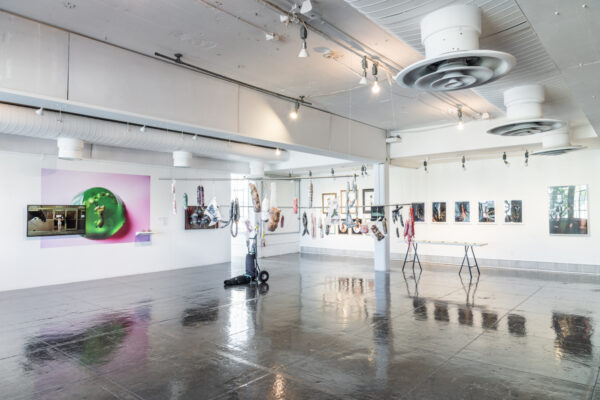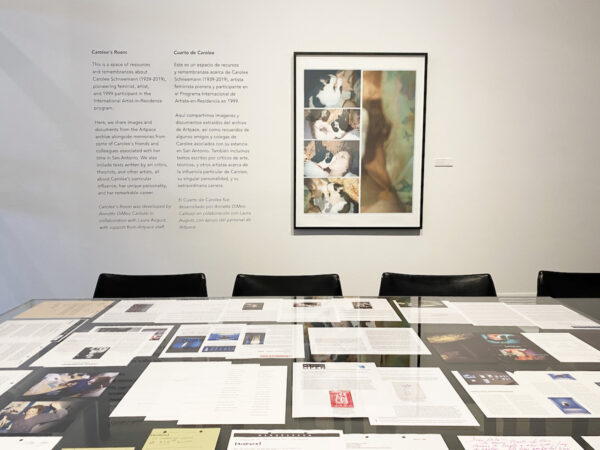“By the year 2000, no young woman artist will meet the determined resistance and constant undermining that I endured as a student… . She will never feel like a provisional guest at the banquet of life.” So predicted the groundbreaking feminist artist and writer Carolee Schneemann (1939-2019) in an essay from the 1970s. Schneemann began her career in New York City in the early 1960s. In those days, male painters stole her brushes and books, claiming that, as men and real artists, they needed her materials much more than she did. The realities and challenges of women’s lives became the driving force behind Schneemann’s pioneering artwork.
Twenty years after her projected date of female artistic liberation, a new group exhibition at Artpace in San Antonio asks the question: have we met Schneemann’s hopes and expectations? After Carolee: Tender and Fierce highlights a new generation of Texas-based female artists working in the wake of Schneemann’s legacy. The multimedia exhibition features 30 recent pieces by artists Amber Bemak & Nadia Granados, Kristen Cochran, Liss LaFleur, Yuliya Lanina, Beili Liu, Paloma Mayorga, Virginia Lee Montgomery, Ayanna Jolivet Mccloud, Lovie Olivia, SAINTLORRAINE (Britt Lorraine & Kristy Perez), Megan Solis, and Julia Claire Wallace.
“When you step back and look at the historical context, you think ‘Wow, things change, and yet they’re still the same,’” curator Annette DiMeo Carlozzi told me in a recent Zoom call. She organized the exhibition to spotlight the “obvious throughline” between Schneemann and contemporary artists working today. “I kept seeing ideas [in young artists] that felt like Carolee to me,” she explained. “The show gave me the opportunity to look backwards and look forwards at the same time, and to think about the resonance of images, actions, and words then and now.”
Before reaching the gallery, visitors encounter Carolee’s Room, a display of documents, photographs, and videos from the artist’s life. Many pertain to Schneemann’s 1999 Artpace residency, where she produced her oneiric, multimedia installation Vesper’s Pool (2000). Inspired by the paranormal events surrounding her cat’s death, the piece explored archetypes of the witchy woman, her feline companion, and the afterlife. Though none of the contemporary artists in After Carolee address Schneemann’s works directly, the archival materials illuminate compelling personal and conceptual crossovers between the two generations of artists that are impossible to ignore.

Kristen Cochran, cured bodies, or the transmogrification of labor into sausages or how atrophy leads to alchemy leads to agency, 2020. Shredded and pulped work clothes, collagen, industrial and cosmetic binders, butchers twine, hog rings, custom rack, custom neon and transformer, dimensions variable. Photo courtesy of Artpace San Antonio.
Suspended sausages hang from long metal poles in the center of the upstairs gallery. Closer inspection reveals that the colorful, chunky forms are composed of compressed cloth. Dallas artist Kristen Cochran shredded other female artists’ work clothes and encased them using collagen, industrial and cosmetic binders, and butchers twine.
The squeezed sausages recall Schneemann’s pinched position at the time of her Artpace residency. Her application laments that — despite museum shows, professorships, and book publications — the artist finds it “increasingly difficult to scrape enough together to find the time and money to create new work.” Cochran’s cured bodies, or the transmogrification of labor into sausages or how atrophy leads to alchemy leads to agency (2020) calls for an alternative, community-generated mode of production. It seems to speak to Carolee’s frustrations, which are still felt by so many artists today. Cochran’s piece also poignantly merges two long-standing, gendered tropes: women’s bodies as meat and the phallic sausage.
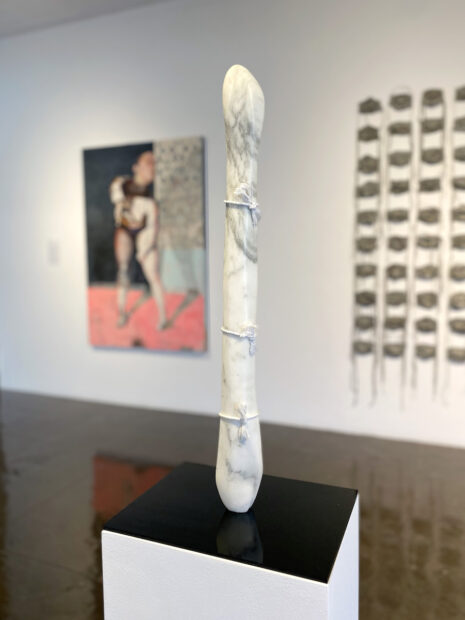
Virginia Lee Montgomery, Marble Ponytail I, 2019. Stone and string, 15 x 5 x 3.” Photo courtesy of Artpace San Antonio.
Another phallic form — Virginia Lee Montgomery’s Marble Ponytail (2019) — stands erect on a pedestal nearby. A mini monolith with Noguchi curves, Montgomery’s sculpture is rigid but fluid, and its clean lines and veined white marble evoke both prehistoric and futuristic associations. Montgomery’s cool reserve contrasts with the mobile messiness of Schneemann performances like Meat Joy (1964) or Up to and Including Her Limits (1973-76), but both artists share an interest in touch: Marble Ponytail’s impeccably polish invites our caress, but as with any otherworldly talisman, we wouldn’t dare.
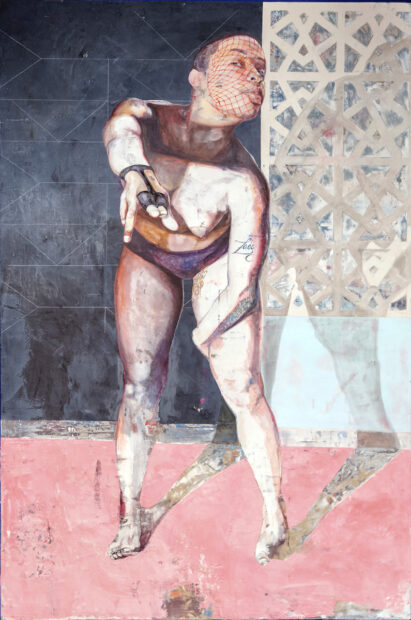
Lovie Olivia, Open Carry, 2018. Plaster, pigment and acrylic on birch plywood, 48 x 72 x 2.” Courtesy of the artist.
The figure in Lovie Olivia’s painting Open Carry (2018) reaches out to touch us— if not lunge at us. Nearly nude, life-sized, and holding a confrontational stance, Olivia’s woman is provocative but complex: her skin’s soft hues, delicate arm tattoo, and thin face netting evade easy reading.
Open Carry was created in response to the 2015 Texas law of the same name. It’s curious that Olivia would respond to current events in fresco secco, an ancient painting technique that involves layering pigment and plaster over the course of months. But the painting’s scraped, pockmarked surface seems to contain a sort of spiritual sedimentation. Schneemann blended aggression, eroticism, and politics, too, though the Houston artist crucially focuses on Black women, Women of Color, and Queer communities, who are largely absent from the art of Schneemann’s era.
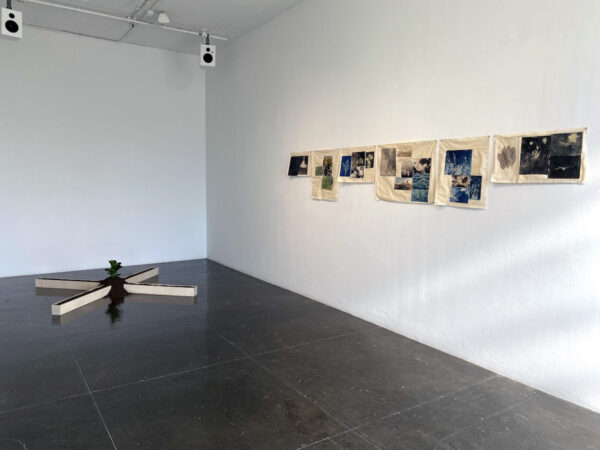
Ayanna Jolivet Mccloud, Balm, 2020. Multimedia installation, sound collage. Photo courtesy of Artpace San Antonio.
Off the main gallery in a small room filled with natural light, Ayanna Jolivet Mccloud’s Balm (2020) combines photo collages, sculpture, and a sound piece. On the wall, cyanotypes and photographs show flowering plants, the night sky, and Black people dancing and wading into the sea. The images suggest a poetic kinship and quiet beauty between the Black body and the rhythms of the natural world.

Ayanna Jolivet Mccloud, Balm, 2020. Multimedia installation, sound collage. Photo courtesy of Artpace San Antonio.
On the floor, two intersecting troughs of dirt form a large ‘X’ where a fiddle-leaf fig grows. The plant is native to Western Africa, and the artist’s statement speaks of the crossroad as “an active space to acknowledge ancestors and the worlds from which they came.” For Jolivet Mccloud, plants are symbols of human origin, ritual, and healing. After all, for a balm to function, it must fuse with the human body.
Jolivet Mccloud’s recognition of the transience of life and the residues of death recalls Schneemann’s Artpace project, but also resonates more generally as Covid has become an unexpected backdrop to the exhibition. “In its broadest sense, the show was about the vulnerability of womens’ bodies in the world,” says DiMeo Carlozzi.“Now every person on this planet is living in this place of precarity: our lives are all being threatened.” In the curator’s view, that threat to the ‘banquet of life’ also has the power to unite. “I hope in the exhibition people might see that joint experience in a way they may not have before.”
On view at Artpace San Antonio through April 25, 2021.



